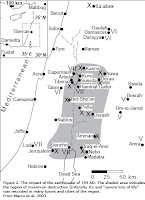Four Stone Hearth 30: at the end of the year

I'm so honored to be hosting this thirtieth edition of Four Stone Hearth. I'm not an anthropologist of any sort, but I love reading this carnival and the blogs that contribute to it, so when Martin put out the call for hosts, I volunteered.
Four Stone Hearth is (as its regular readers know) a biweekly collection of posts in four sub-fields of anthropology, each sub-field one of the hearth's stones.
archaeology
 theraaa at Dead Sea Landscapes writes about Dead Sea Earthquakes - History, Archaeology and Doomsday Predictions: "just a little research shows that it takes more than to select a small number of major quakes within the national boundaries of Israel to suggest a pattern and make doomsday predictions."
theraaa at Dead Sea Landscapes writes about Dead Sea Earthquakes - History, Archaeology and Doomsday Predictions: "just a little research shows that it takes more than to select a small number of major quakes within the national boundaries of Israel to suggest a pattern and make doomsday predictions."At Remote Central Tim Jones takes a look at Range Creek Canyon, Utah, once home to the Fremont Indians whose culture ceased around 1300 AD: "one of the most intact sites of its kind anywhere in the Western US, partly due to its remote location, as well as having been closed to the public for 75 years after its modern-day discovery." (And there's a film!)
Also from Remote Central is another in Terry Toohill 's ongoing series of essays concerning human evolution: The First Humans: "Of course Human Evolution is impossible until we have humans. Unfortunately, even with all the evidence available, it is impossible to decide when we first became human. Or even what the defining change was. We certainly can’t use technology to identify our ancestors..."
At Archaeozoo is a fascinating look at frog legs in the diet of the Eneolithic people of the Czech Republic: "Approximately 15,000 fragments were analysed from the site at Kutna Hora-Denemark in central Bohemia... In general, frog bones dominate the number of identified bones from the site."
Michael E. Smith at Publishing Archaeology talks about the hazards of burying your paper in an edited volume: "Two of my best papers were published in edited volumes, and I still regret not sending the first of these to a journal, where it would have had a much wider readership. It sits moldering in a mediocre volume not much consulted any more."
 Archaeology magazine lists its 'Top 10 Discoveries of 2007: "Reducing a year's worth of these stories to the 10 most important was a tall order, especially since our intent was to go beyond the headlines and select those we thought made a significant impact on the field--ones that will be talked about for decades." They add, "Of course, we couldn't agree on our own top ten, and many of us lobbied for stories that didn't make the final cut. So, we have added here nine of 2007's other most important finds."
Archaeology magazine lists its 'Top 10 Discoveries of 2007: "Reducing a year's worth of these stories to the 10 most important was a tall order, especially since our intent was to go beyond the headlines and select those we thought made a significant impact on the field--ones that will be talked about for decades." They add, "Of course, we couldn't agree on our own top ten, and many of us lobbied for stories that didn't make the final cut. So, we have added here nine of 2007's other most important finds."And on the flip side, A Hot Cup of Joes gives us the year in pseudo-archaeology: "a few stories that presented some bad archaeology with a summary of each that includes the primary assumptions and faults they rely on."
socio-cultural anthropology
Jason Zanon at Executed Today.com posts about Francisca Nunez de Carvajal: "On this date in 1596, the Inquisition sent nine Jewish converts to Christianity to the stake in Mexico City for Judaizing — a cruel fate offering a window into a secret history of New World settlement."
Kai Sheffield at Terry* discusses "a uniquely American obsession: knowing the exact weight of extremely large objects"
Alun at Clioaudio has a thought about Deep History, arguing that "it's not just an extended timescale which archaeology can bring to history. There's also a matter of technique."

And one more from Remote Central, in which Tim Jones has a brief look at a proposed Creationist theme park in Britain: Let There Be Theme Parks.
bio-physical anthropology
Greg Laden (at Greg Laden's Blog) tells us that "There is a new paper:, just coming out in Proceedings of the National Academy of Sciences, that explores the idea that humans have undergone an increased rate of evolution over the last several tens of thousands of years."
 And John Hawks (at John Hawks Anthropology Weblog), one of that paper's authors, discusses Why human evolution accelerated: "Like most good stories in biology, this one begins with Darwin. Darwin was always very interested in animal breeding, which he considered the best analogy for the process of natural selection.... These words from the Origin, "number is of the highest importance for success" were influential. This is a quick review of the research, based on a presentation I gave earlier this year. It is not complete, and glosses a number of very important details. A close reader looking for how to do genomics would be better served reading the actual research paper. Here, I'm trying to express the science for everyone else."
And John Hawks (at John Hawks Anthropology Weblog), one of that paper's authors, discusses Why human evolution accelerated: "Like most good stories in biology, this one begins with Darwin. Darwin was always very interested in animal breeding, which he considered the best analogy for the process of natural selection.... These words from the Origin, "number is of the highest importance for success" were influential. This is a quick review of the research, based on a presentation I gave earlier this year. It is not complete, and glosses a number of very important details. A close reader looking for how to do genomics would be better served reading the actual research paper. Here, I'm trying to express the science for everyone else."More genes and agriculture come from Yann Klimentides (at Yann Klimentidis' Weblog) in NAT2 variants and the transition to agriculture in Central Asia: "First what is NAT2? It's a gene involved in the acetylation of xenobiotics (foreign substances) and carcinogens - basically getting rid of toxins. They hypothesize that they will find different versions of this gene depending on whether a group is traditionally pastoralist or agriculturalist. They focus in on Central Asia where there is still some diversity among groups in subsistence."
PZ Myers at Pharyngula looks at the load-bearing adaptation in women's spines: "Here's the interesting part: women have changed the shape of individual vertebrae to better enable maintenance of this increased curvature, called lordosis, and fossil australopithecines show a similar variation."
Aaron Filler, MD and PhD, at Anthropology.Net looks at the evolution of lordosis and pregnancy, too: "The report published in Nature by Whitcome, Shapiro, and Lieberman reports on a longitudinal study of 19 pregnant women to show how the center of gravity moves forward as the pregnancy progresses and also identifies male/female differences in lumbar curvature or lordosis. They make the point that this assembles into a neat evolutionary adaptationist story - females have more lumbar lordosis than males (sexual dimorphism) and this appears to be helpful for the unique demands of a pregnant upright biped. "
 He also asks "Do we really need to consider turning everything upside down by considering the existence of a human ancestor for the apes? This suggestion definitely has the quality of blasphemy against religious doctrine. It just feels wrong and goes against our deeply held beliefs and understanding of the world.However, this is exactly where the evidence leads."
He also asks "Do we really need to consider turning everything upside down by considering the existence of a human ancestor for the apes? This suggestion definitely has the quality of blasphemy against religious doctrine. It just feels wrong and goes against our deeply held beliefs and understanding of the world.However, this is exactly where the evidence leads."Razib, at Gene Expression, asks Menopause in chimps? or not?, a look at 'The Grandmother Hypothesis': "Roughly, the question is why do women go through a "change" which rapidly shifts them from being able to become pregnant, though at sharply reduced rates by the time that menopause occurs, to a state of infertility where they may survive for up to three decades?"
linguistic anthropology
Mark Liberman at Language Log looks into the whys and whens of using hyphens in American Indian names ("But there's more to it, because earlier sources don't use this style. Thus Benjamin Smith Barton's "New views of the origin of the tribes and nations of America", 1797, contains long vocabulary lists compiled from multiple sources, in which hyphens are quite rare.") with a follow-up that references similar practices with indigenous Australian names
 Eric Bakovic at There's a pattern here to see tells us that an NSF documentary, produced by Ironbound Films, called The Linguists will be featured at Sundance this year. The film stars K. David Harrison, author of When Languages Die.
Eric Bakovic at There's a pattern here to see tells us that an NSF documentary, produced by Ironbound Films, called The Linguists will be featured at Sundance this year. The film stars K. David Harrison, author of When Languages Die.And that wraps up the thirtieth edition of Four Stone Hearth. I hope you've enjoyed it. Next time will be January 2, 2008, at Walking the Berkshires. If you would like to submit content to the next issue of the carnival, please send an email to submit@fourstonehearth.net.
























6 Comments:
-
At 8:03 AM, December 19, 2007
 Tim Jones had this to say...
Tim Jones had this to say...
-
-
At 10:19 AM, December 19, 2007
 ExecutedToday had this to say...
ExecutedToday had this to say...
-
-
At 11:33 AM, December 19, 2007
 Mike the Mad Biologist had this to say...
Mike the Mad Biologist had this to say...
-
-
At 12:09 PM, December 19, 2007
 AbbotOfUnreason had this to say...
AbbotOfUnreason had this to say...
-
-
At 5:42 AM, December 20, 2007
 Anonymous had this to say...
Anonymous had this to say...
-
-
At 11:28 AM, June 17, 2008
 Anonymous had this to say...
Anonymous had this to say...
-
-
<-- Older Post ^ Home Newer Post -->Very nice edition, and thanks a lot for hosting this time round.
Thank you for the link and for hosting ... what an excellent collection to be a part of!
Great Job!
Nice stuff. When I read this:
"On this date in 1596, the Inquisition sent nine Jewish converts to Christianity to the stake in Mexico City for Judaizing — a cruel fate offering a window into a secret history of New World settlement."
I thought that Judaizing was the cruel fate...
Great edition! Thanks for including me!
Good JoB! :)
Post a Comment
Subscribe to Post Comments [Atom]